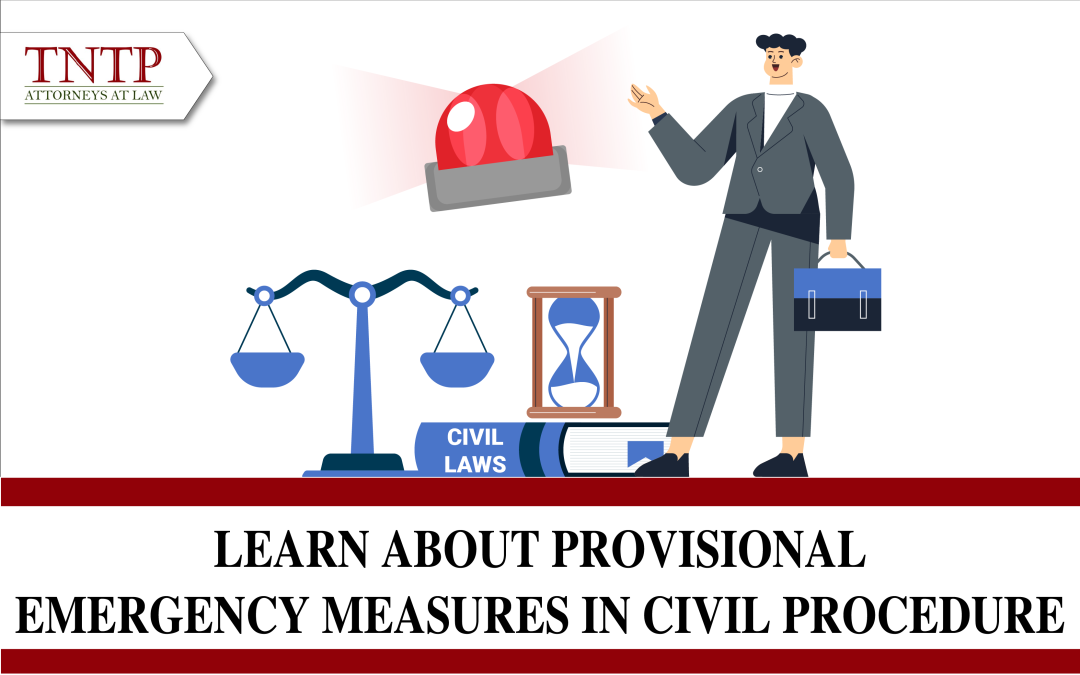In civil proceedings, in order to protect the rights and interests of the involved parties as well as ensure the enforcement of judgments, the Court may apply provisional emergency measures as prescribed in the Civil Procedure Code. As society develops, life will become more and more complicated, and there will be acts infringing the rights and interests of others. Therefore, provisional emergency measures are a tool for the State to intervene through the legal corridor to promptly protect the rights and interests of the involved parties in civil proceedings. In this article, TNTP lawyers will analyze and clarify provisional emergency measures as prescribed in the Civil Procedure Code so that readers can better understand this legal issue.
1. What is a temporary emergency measure?
According to Article 111 of the 2015 Civil Procedure Code, provisional emergency measures are measures decided by the Court to apply when resolving a civil case to resolve the urgent requests of the parties, protect health, property, life, protect evidence, collect evidence, preserve the current state, avoid causing irreparable damage, ensure the execution of judgments and settlement of cases.
2. Features of Provisional Emergency Measures
Provisional emergency measures have the following two distinctive features:
• Urgency: Demonstrated through the fact that the Court will issue a decision for immediate application and this decision will be enforced immediately after that.
• Temporary: Provisional emergency measures cannot completely resolve the problems facing the parties. The measures are applied temporarily to meet the urgent requirements of the parties, protect life, health, property, collect and protect evidence, preserve the current state, avoid causing irreparable damage, ensure the execution of judgments and settlement of cases.
3. Summary of provisional emergency measures
(i) Sending minor persons, legally incapacitated persons, person with limited cognition or behavior control to individuals or organizations for nurturing, taking care of and educating;
(ii) Force to perform part of the alimony obligation in advance;
(iii) Force to perform of part of the obligation to compensate for damage to individuals whose lives and/or health have been infringed upon in advance;
(iv) Forcing the employers to provide the employees with advance wages, health insurance, social insurance, treatment cost for occupational accidents or occupational diseases or compensations, allowances for occupational accidents or occupational diseases;
(v) Suspending temporally the execution of decisions on unilateral termination of labor contract or decisions on dismissal of employees;
(vi) Distraining the disputed properties;
(vii) Prohibiting the transfer of property right over the disputed properties;
(viii) Prohibiting the change of the current conditions of disputed properties;
(ix) Permitting the harvesting, sale of subsidiary food crops or other products, commodities;
(x) Freezing accounts at banks or other credit institutions, State treasury; freezing properties at places of their deposit;
(xi) Freezing properties of the obligor;
(xii) Prohibiting involved parties from performing, or forcing them to perform certain acts;
(xiii) Prohibiting the obligors from leaving Vietnam;
(xiv) Prohibiting the contact with victims of family violence;
(xv) Suspending the bid closing and activities related to bidding;
(xvi) Arresting aircrafts or ships to ensure the lawsuit settlement;
(xvii) Other provisional emergency measures provided for by law.
4. Applying provisional emergency measures
a) When the case is being resolved:
Pursuant to Clause 1, Article 111 of the Civil Procedure Code 2015 and Article 2 of Resolution 02/2020/NQ-HDTP, the involved parties have the right to request the Court to apply provisional emergency measures during the settlement process when meeting the following cases:
• Temporarily settle the urgent request of the involved parties directly related to the case being resolved by the Court that needs to be settled immediately. If delayed, it will adversely affect the life, health, livelihood, property, honor, and dignity of the involved parties.
• Collect and protect relevant evidence of a case being handled by the Court in cases where the parties obstruct or negatively impact the collection of evidence or are destroying or are at risk of destroying evidence, making it difficult to collect it again later.
• Preserve the existing status, avoid causing irreparable damage, preserve the subjects and relationships directly related to the case being resolved by the Court.
• Ensure the basis for resolving the case and have sufficient conditions for enforcement when the Court’s judgment or decision is enforced.
b) Emergency situation:
Pursuant to Clause 2, Article 111 of the Civil Procedure Code 2015 and Article 3 of Resolution 02/2020/NQ-HDTP, individuals, agencies and organizations have the right to request the Court to issue a decision to apply emergency measures in case of an emergency requiring the protection of evidence and prevention of possible serious consequences and submit the request at the same time they file a lawsuit if there is one of the following grounds:
• Urgent situations need to be resolved immediately and cannot wait or delay.
• Evidence needs to be protected in cases where the source of evidence may be destroyed, is at risk of being destroyed, or is difficult to collect in the future.
• Prevent possible serious consequences (physical or mental).
c) The court issues a decision to apply provisional emergency measures by itself
Pursuant to Article 135 of the Civil Procedure Code 2015 and Article 5 of Resolution 02/2020/NQ-HDTP, the Court itself will issue a decision to apply provisional emergency measures if all of the following conditions are met:
• The application is directly related to the case being resolved.
• The application is really necessary to meet urgent requirements and fall into the scope of Clause 1, 2, 3, 4, 5 of Article 114 and from Article 115 to Article 119.
• The party does not make a request to apply provisional emergency measures due to objective obstacles or legitimate reasons.
Above is the article of TNTP on “Learn about provisional emergency measures in civil procedure” shared with readers. Hopefully this article will be helpful to readers.
Sincerely,







